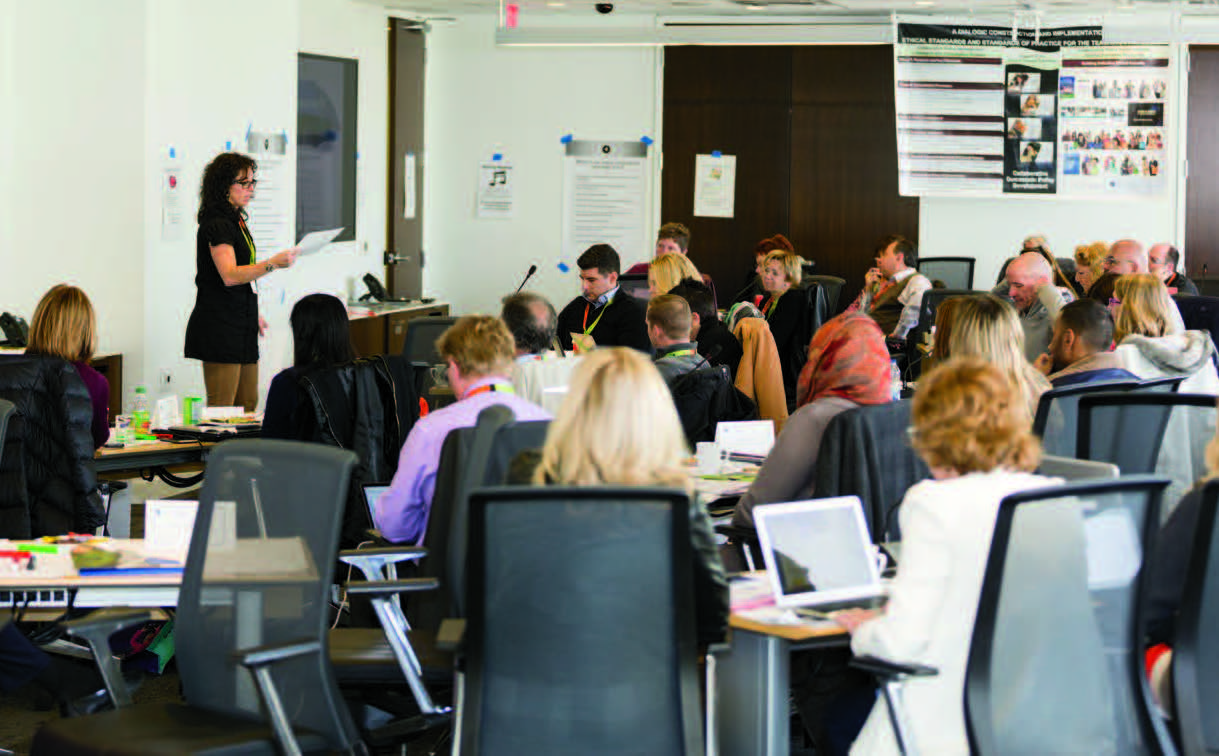Share this page
By Melissa Campeau
Photos: Ontario College of Teachers

What a teacher ultimately experiences and learns in an AQ course begins as questions and conversations during the guideline development phase. In addition to a systematic and rigorous research and literature review process, the AQ development team at the College seeks the input of as many voices as possible, in a variety of settings, including consensus workshops and focus groups, and even online questionnaires and Facebook discussions.
“It’s one of the College’s objects to provide for the ongoing education of its members,” says Déirdre Smith, OCT, manager of the College’s Standards of Practice and Education Unit.“When we’re developing AQ guidelines, it’s important that we consult students, families, community partners, teachers and all stakeholders,” she adds. “It’s a democratic process and it’s essential.” A broader range of voices factoring into the development phase result in AQ guideline content that’s more reflective of Ontario students’ needs.
A few years ago, one of those AQ research discussions involved reaching out to Dawn Clelland, a volunteer member of the Ministry of Education’s Special Education Advisory Committee, representing students who are blind or have low vision. Clelland was asked for her thoughts on the College’s draft AQ guideline for teaching blind children.

Clelland, who lives in Kitchener, is also a parent of a 17-year-old blind daughter, so she understands first-hand the kind of assistance teachers need when dealing with blind and visually impaired children. Combined, her personal and professional experience told her the guidelines still needed some work. “I was really direct with the College. I told them the course wasn’t adequate,” says Clelland. “It had nothing on helping blind students with math, nothing on braille, nothing about using technology to help the students. There were many components that were missing.”
Clelland voiced her concerns in detail and recommended the College consult with some additional teachers working in this specialized area. “All I did was ring the bell and say this needs to be better and this is who you need to talk to,” she says. “The College was really receptive and genuinely committed to making the guidelines the best they could be,” says Clelland. “That openness has turned into a positive change for our children’s teachers.”
Pierre Beaudin, OCT, has a similar story. In 1995, his second child, Mélodie, was born deaf-blind. Immediately, Beaudin began researching and learning all he could on the subject. When Mélodie was 5, he enrolled in the College’s Deaf-blind AQ. Then, while serving as an education consultant for the deaf-blind at the Ministry’s Centre Jules-Léger in Ottawa, he was asked to contribute to the development of revised guidelines for the specialist Deaf-blind AQ course, which is offered in both French and English.
“I was invited by the College — along with other teachers, parents, con- sultants and experts — to share my own personal experiences as a father, as an education consultant with experience in the field, and also as a francophone,” says Beaudin. “They were very open to understanding what deaf-blindness means to the parents of a deaf-blind child and what it means to an education professional.” He adds, “There’s a very emotional aspect to this, it’s not just theoretical, and they were very willing to consider that.”
Beaudin believes this is a critical strength of the AQ. “That’s a fundamental and essential step in ensuring that a guideline in the end will represent more than just theoretical aspects — it will be flexible and take into account the human dimension of these children and their families.” He adds, “This kind of attention to detail makes all the difference for a teacher and for that teacher’s students.”
In line with the Ministry of Education’s curriculum review, which usually takes place every seven years, the College reviews and updates each AQ course. Frequently taken courses, such as Special Education, are reviewed every five years. AQ courses for principals and supervisory officers are reviewed every five years, as well.
Once course guidelines are drafted, they’re posted on the College website. Members of the public and the profession are invited to review the guidelines and submit comments or concerns, all of which will be considered before the guidelines become final. College members interested in getting involved in the AQ development process should email info@oct.ca.
Provider institutions are welcome to use the posted draft guidelines for new or revised AQs, with the understanding that any and all adjustments to the guidelines, once finalized, should be reflected in their courses.